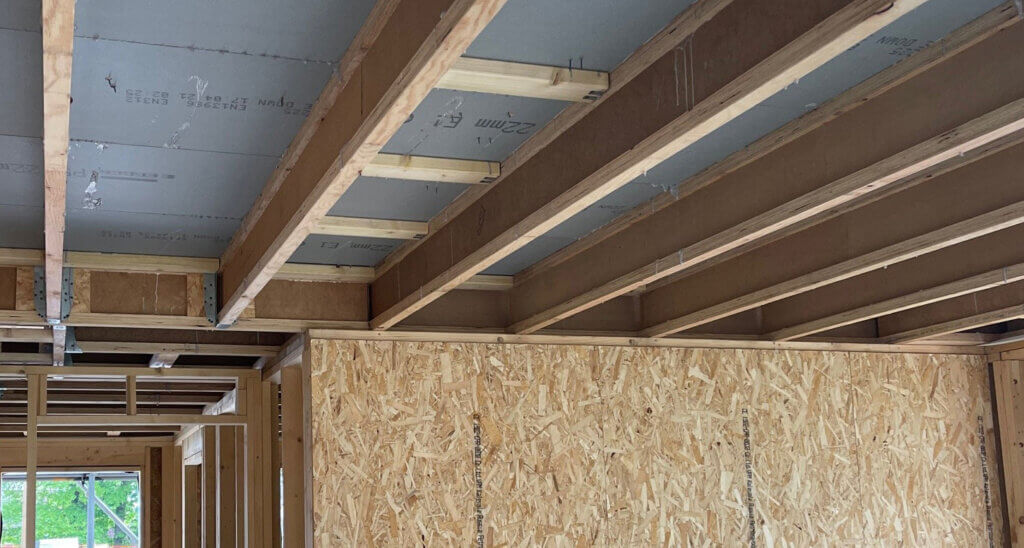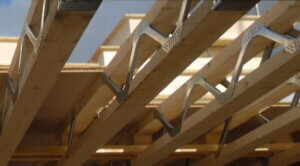SIP Floors and Decking
Benefits of Underfloor Heating
Underfloor heating is installed beneath the floor surface, providing a source of radiant heat. Underfloor heating offers several benefits, making it an attractive option for many homeowners and developers.
SIPs structures with their exceptional thermal performance and air pressure test results maximise the performance and efficiencies of these systems!
Even & Comfortable Heat Distribution:
Underfloor heating provides consistent heat distribution across the entire floor surface, it eliminates cold spots and temperature variations, creating a more comfortable indoor environment.
Energy Efficiency:
Underfloor heating can be more energy-efficient compared to traditional heating systems such as radiators. Radiant heat warms the room from the floor up, allowing for lower operating temperatures and reduced heat loss helping the airtight SIP system perform.
Reduced Energy Costs:
Lower operating temperatures and improved heat distribution can lead to reduced energy consumption, resulting in lower heating bills over time. It can be especially cost-effective with well insulated SIP homes.
Space-Saving:
Unlike radiators underfloor heating systems are hidden beneath the floor, freeing up wall space and allowing for more flexible interior design options. Add this together with SIP wall build ups and there is a huge potential to create more habitable living space.
Aesthetic Appeal:
No radiators enhances the aesthetics of a room. It provides a clean, clutter-free look, allowing furniture and decor to be placed freely without the need to work around heating equipment.
Improved Air Quality:
Underfloor heating reduces the circulation of airborne allergens, as it doesn’t rely on forced air. This can contribute to better indoor air quality, especially for individuals with allergies or respiratory conditions. Add in a Mechanical Heat Recovery System (MVHR) and you are really improving the internal air quality, we would highly recommend this with an airtight SIP home.
Silent Operation:
Underfloor heating systems operate silently, eliminating the noise associated with traditional heating systems. Limit the air popping in radiators or whooshing or the system when they start up.
Zoning and Individual Control:
Underfloor heating systems can be divided into zones, allowing for individual control of the heating in different zones within the home. This can lead to further energy savings.
Longevity and Low Maintenance:
Underfloor heating systems are typically durable and have a long lifespan. They require minimal maintenance compared to some other heating systems.
Luxurious and Comfortable Feel:
Walking on a heated floor can be a luxurious and comfortable experience, especially during cold winter months. Fantastic for those with cold feet or little ones who refuse to wear socks!!
Property Value:
Underfloor heating can add value to a property and make it more appealing to potential buyers or renters.
SAP10 / energy compliance:
In conjunction with a SIP build underfloor heating and other measures such as MVHR and or solar really help ensure that your dwelling complies with the current regulations for energy compliance.
What is an I-Joist
An I-joist (also known as engineered timber joist, I-beam), is a type of structurally engineered timber product commonly used for flooring in residential construction. It is designed to provide strength and stiffness to floor and roof framing systems.
I-joists typically consist of an “I” shaped cross-section which are made by combining OSB or plywood web with solid timber or laminated veneer timber flanges. The flanges are usually oriented vertically, while the web runs horizontally between them.
This design maximizes the strength-to-weight ratio of the joist. 
The use of I-joists offers several advantages in construction, including consistent strength, dimensional stability, and the ability to span longer distances compared to traditional solid wood joists. I-joists are known for their efficiency, as they can provide the same structural performance with less material than traditional joists.
Advantages of I-joists versus Timber joists.
- Easy handling and installation
- Structural and dimensional stability
- Long continuous spans
- Reduced site wastage
- Environmentally sustainable
- Lower swelling and shrinkage rates versus timber joists.
What are Metal Open Web Joists
Metal open web joists (MOW) have long been used in the UK construction industry and are continually growing in popularity with architects, specifiers, home builders and contractors.

They share the same basic elements as trussed rafters – structural timbers joined with pressed-steel nail plates to create a rigid frame. Not surprisingly then, many of the UK’s manufacturers of Metal open web joists are also trussed rafter manufacturers.
With the increasing specification of mechanical ventilation and heat recovery (MVHR) systems and smart home systems adding to the services occupying the floor zone, Metal open web joists are very much the go to product when building a SIPs home.
Advantages of Metal Open Web Joists versus I-Joists and solid timber joists:
- Easier installation of services e.g. electrics, plumbing, MVHR ducting
- No cutting or drilling holes in the joist
- The use of smaller timber sections together with the metal open webs means that there is less shrinkage and a reduced risk of squeaky floors
- As Metal open web joists are made to measure, site wastage is virtually eliminated
- The open web structure means they are lighter to handle than solid timber joists
- Metal open web joists can sometimes eliminate the need for loadbearing intermediate walls, giving the architect greater design freedom and flexibility
- Metal open web joists when used with a rigid strongback reduce floor vibration
- Increased spans, simpler installation of utilities, flexibility in design and faster erection can result in significantly reduced building costs
- The depth, length and specification can all be adjusted to produce joists with specific performance criteria that can span greater distances than solid timber joists
- Top Hung Metal open web joists within SIP systems remove the need for time consuming joist hangers. This leads to a faster installation.
Based on previous projects our clients preference is the MOW joist as it allows for greater spans meaning less structure and provides far more efficiencies for follow on trades when installing M&E systems such as MVHR and smart home systems.

